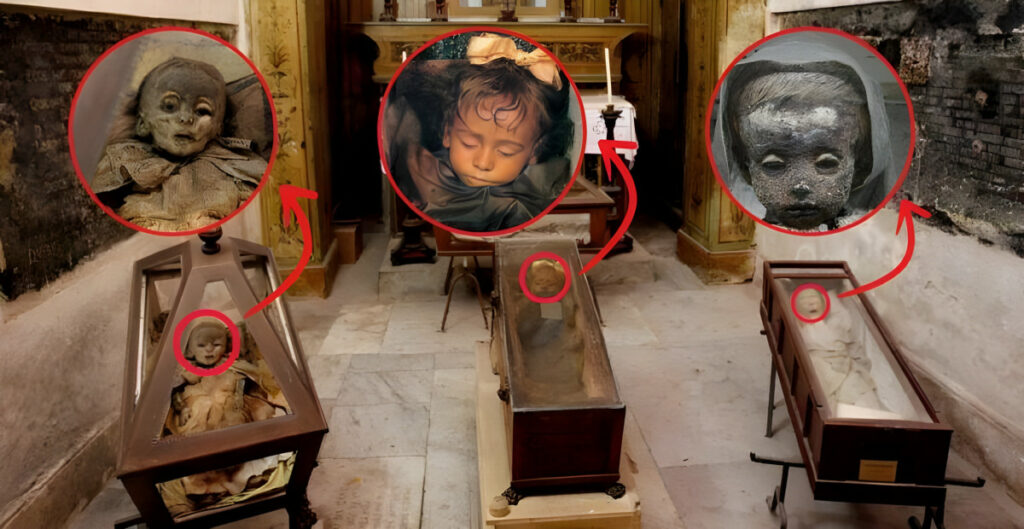Deep within the intriguing Capuchin Catacombs of Palermo in northern Sicily lies a mystery that has captivated historians and researchers for decades. Among the eerily preserved mummies lining the walls of this ancient burial site, a specific group stands apart – the mummified remains of children. These young souls, silent witnesses to a bygone era, hold secrets that are only now beginning to be uncovered.
For centuries, the stories of these children have remained untold, their identities shrouded in mystery. A dedicated team of researchers from Staffordshire University in England has taken on the challenge of unraveling these enigmas. Using non-invasive X-ray technology, they aim to explore the lives, identities, and deaths of the mummified children, offering a rare and profound glimpse into a lesser-known chapter of history. This groundbreaking investigation focuses on the “Children’s Room” within the catacombs, where 41 meticulously preserved child mummies are housed. However, this is only a fraction of the estimated 163 child mummies scattered throughout the site. Among them, a particular child mummy displayed on January 31, 2011, has become the centerpiece of this captivating research.

Dr. Kirsty Squires, the principal investigator, explains the unique approach of her team: “Previous studies have largely concentrated on the adult mummies found in the catacombs, but our focus is different. We aim to uncover the identities and stories of these children. By leveraging non-invasive X-ray technology, we hope to better understand why they were laid to rest in this sacred space and what their lives might have been like.”
The ethical considerations surrounding such research are not lost on the team. Dr. Squires emphasizes their unwavering commitment to respectful and sensitive research practices. Collaborating closely with the Capuchin friars, the custodians of the catacombs, the researchers are ensuring that their work honors the dignity and humanity of the deceased. “It is vital that we approach this investigation with the utmost respect and care,” Dr. Squires explains. “These are children, and we have a responsibility to preserve their memory with dignity. That’s why we have opted for non-invasive methods like X-rays rather than employing intrusive techniques such as autopsies.”
This commitment to preserving dignity extends to the way the team shares their findings with the public. Instead of displaying photographs of the mummies on social media, the researchers have partnered with artist Eduardo Hernandez to create vivid illustrations of the catacombs. These artistic depictions allow the public to engage with the history and significance of the mummified children without confronting distressing images. “We understand the natural curiosity and fascination surrounding these discoveries,” says Dr. Squires. “However, we also have a duty to protect the sanctity of these individuals and their final resting place. By working with an artist, we can share their stories in a way that is both informative and respectful.”
The Capuchin Catacombs, established in 1599, have long been a site of fascination. Originally created to house the naturally mummified remains of Capuchin monks, the catacombs later became the final resting place for wealthy and prominent individuals, whose mummified remains were displayed as symbols of status and prestige. Today, the catacombs are home to approximately 1,284 bodies, many of which are considered some of the best-preserved mummies in the world. While the adult mummies have been the subject of numerous studies and public intrigue, the presence of mummified children adds a poignant and mysterious layer to this historical treasure.
Through their innovative research, the Staffordshire University team hopes to illuminate the untold stories of these children. By uncovering their identities and exploring the cultural and historical context of their time, the researchers aim to honor these young lives and expand our understanding of the past. Dr. Squires and her team are driven by the belief that these children deserve to have their stories told, their humanity recognized, and their memories preserved for future generations.
The Capuchin Catacombs serve as a powerful reminder of the interplay between life and death, past and present. For centuries, this sacred site has captured the imagination of visitors from around the world, offering a unique window into the customs, beliefs, and practices of those who came before us. Now, thanks to the dedicated efforts of researchers like Dr. Squires, the mummified children of the catacombs are finally being given a voice. Their stories, long hidden in the shadows, are emerging to inspire and enlighten us all.
As this research unfolds, it promises to shed new light on the resilience and complexity of human history. The world watches with anticipation, eager to learn what secrets these ancient mummies will reveal and how their stories will reshape our understanding of the past. Beyond the scientific discoveries, this investigation serves as a poignant reminder of our shared humanity. In studying the lives and deaths of these children, we gain insight not only into their world but also into the enduring connections that bind us across time.
The Capuchin Catacombs stand as a testament to the enduring power of history and memory. They remind us of the importance of honoring the past while striving to learn from it. Through respectful and innovative research, Dr. Squires and her team are not only uncovering the stories of these mummified children but also helping us to see the threads of humanity that connect us to those who lived long before us. As we continue to delve into the mysteries of this sacred site, let us approach it with reverence and respect, recognizing the profound stories it holds and the lessons it offers.





